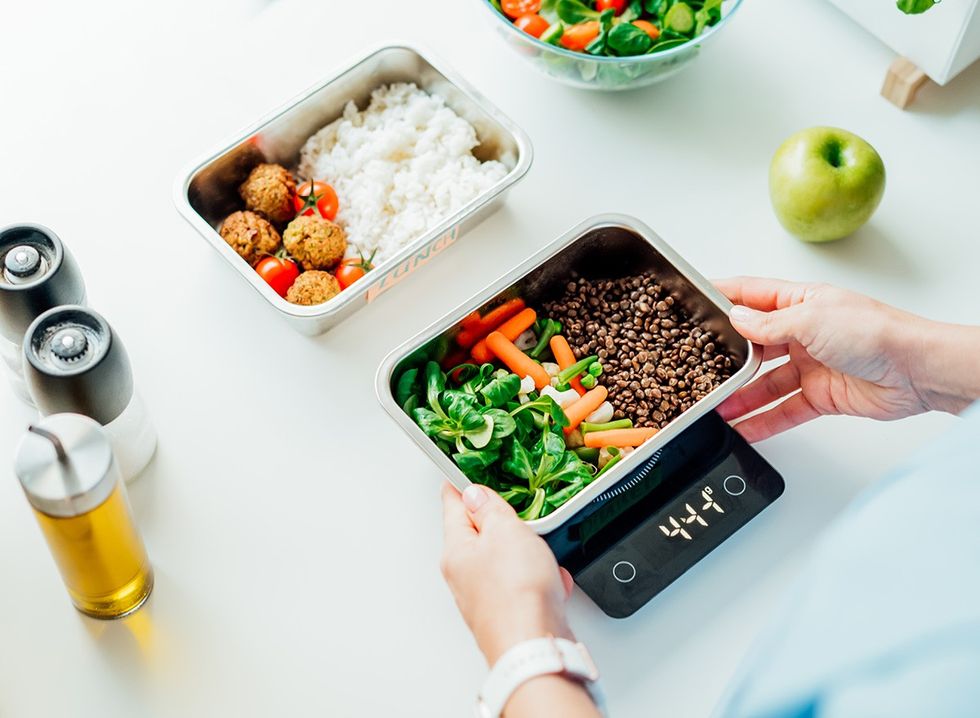You might think you are eating healthy, but you are actually consuming foods that are bad for you. Autumn Bates (@autumbates) is a Clinical Nutritionist who has a Master's in Nutrition Human Performance and is a social media influencer with hundreds of thousands of followers. Her videos, which focus on healthy eating, weight loss, and intermittent fasting, regularly go viral, including a recent video highlighting healthy foods that aren’t actually healthy. “I'm gonna be sharing 10 different health foods that are actually pretty sketchy and are something that you might want to look into avoiding. Some of them are pretty surprising,” she says, adding that “chances are you're probably having some of these already.”
Margarine
 Shutterstock
Shutterstock
You may have grown up thinking that margarine is healthier than butter, but according to Bates, this isn’t correct. “Margarine is basically some type of vegetable oil” that is solid at room temperature. “This is not something natural. Vegetable oil should not be solid at room temperature, which means that they're physically reconfiguring the chemical. So at the molecular level, they're literally changing these molecules into something that isn't naturally found in nature,” she points out.
Low Fat Yogurt
 Shutterstock
Shutterstock
The second item on her list? Low fat yogurt. “Yogurt isn't naturally low fat. In order to make it low fat, they have to remove the fat in the first place. So considering there's only three different macronutrients, meaning protein, carbs, and fat, then when they remove a pretty major component of the yogurt, which is fat, then they have to replace it with something else,” she reveals. “And in most cases, for these low fat yogurt, they're adding back in carbohydrates in the form of sugar. Now, fat is satiating. It helps to make it so that you're actually feeling full after your meals. Carbohydrates don't have those same satiating effects, especially when they're in the form of a simple sugar. So not only will you not be satiated, but you'll want to eat more often throughout the day and it'll likely cause you to crave even more sugar. Plus sugar has that anabolic fat storing response. So swapping regular yogurt for low fat yogurt is actually working against your goals.”
Processed Vegan Meats
 Shutterstock
Shutterstock
Number three? Processed vegan meats, including Beyond Meat. “Now, one of the reasons why people see benefits when they go more plant-based is because they're incorporating more plant foods. Plant foods contain a variety of different micronutrients, all of which will actually benefit health. But when you're utilizing something like fake meats instead of a more plant-based whole source of protein, like with beans, lentils, peas, you're getting a much more processed food, and that means you're missing out on a lot of the benefits that come along with incorporating more plants into your diet,” she says. There are also lots of other additives you should not be eating. “So when it comes to incorporating more of a plant-based diet, it's always just best to get it from the whole source because you're going to miss out on getting any potential negative side effects of the additives that go along with these fake meats, and you're going to get all the benefits of the whole plant itself.”
RELATED: 9 Key Differences Between Ozempic and Other GLP-1 Meds for Weight Loss
Low Calorie Ice Cream
 Shutterstock
Shutterstock
Number four, low calorie ice creams. “So this is one such as Halo Top, but there's a lot of other different ice creams that I've seen that are in the market now, and these seem pretty enticing. Because I mean, who wouldn't be excited when you saw the whole pint of ice cream's only 280 calories? It seems guilt free, and that's really what they're marketed as. But these low calorie types of ice creams really rely on sugar alcohols for the sweetness factor, and these sugar alcohols can cause GI distress in a lot of people,” she says.
RELATED: Lose Abdominal Fat in 60 Days with the DASH Diet
Prepackaged Juice
 Shutterstock
Shutterstock
Number five, prepackaged juices. “So there can be benefits from juicing your vegetables, especially because our farming is so nutrient poor, so it's hard to get a lot of the minerals that our body needs from just the food itself,” she says. She adds that a lot of the juices aren’t organic, “which means that you're going to be increasing your pesticide intake and you're essentially just drinking like a pesticide juice at that point,” she says. “If you are going to juice, then you're best off either going to a local organic juice shop where they're actually making the juice right in front of you and you can see it and you see what's going into it or making it yourself and getting the veggies from a local farmer's market.”
Prepackaged Butter Coffees
 Shutterstock
Shutterstock
Number six, prepackaged butter coffees. While she loves keto coffee and the benefits it offers, most of the prepackaged options “undermines the purpose of keto coffee in the first place,” she says. “So this happens a lot with food production companies when they see that there's a trend going on in what people want, they automatically go to mass produce it, but they want to create the product even more flavorful, which tends to be for them adding more sugar so that the consumer will be more likely to buy it and then continue buying it.”
RELATED: Lose 20 Pounds in 75 Days with the Flexitarian Diet
Gluten-Free Cereal
 Shutterstock
Shutterstock
Number seven on the list is gluten-free cereal. “In the last 10 years or so, gluten has gotten a really bad reputation and so people are trying to avoid it in general, and this mass avoidance of some types of food can lead to using way too much of another type instead,” she points out. “Plus, it makes it seem like just because something is gluten-free means that it's good for you. And that's definitely not the case. Sugar is technically gluten-free, but it doesn't mean that you should be pouring sugar all over your food. And with that in mind, a lot of these gluten-free products typically contain a lot of additives that will help to make the product have the same texture as the gluten containing product. So it's much more processed than if you were to just use the original version. Plus it's still cereal, so it likely contains a high amount of sugar anyway, and that'll just cause us crazy spikes and falls in blood glucose levels that will work against your wellness goals in the first place.”
Gluten-Free Crackers
 Shutterstock
Shutterstock
Next up, gluten-free crackers or chips, the “same exact concept,” as gluten-free cereal. “Just because they're gluten-free, it does not mean that it's healthy for you. And like I mentioned, these gluten-free products are typically more processed, contain more sugar and have more additives in general. And that's again, to make it actually taste like the original product that contains gluten in the first place.”
Nut Milk or Dairy Free Yogurt
 Shutterstock
Shutterstock
Number nine, nut milk or dairy free yogurts, which is “along the same type of mindset as the gluten-free issue,” she says. “You know, a lot of people are trying to avoid dairy because some people have some issues with dairy or because again, dairy has gotten a bad reputation, but specifically with yogurts, one of the reasons why it's actually able to form the yogurt is because bacteria is feeding off of the natural sugars that are within milk. Now, almond milks or other types of milk don't necessarily have the same natural sugar that bacteria is able to ferment, which means that they have to add it in. So you're getting a lot of added sugars with this. You're also probably getting a lot of different gums and additives as well in order to make that same consistency that other yogurts have. So again, it's a much more processed product.” She recommends “real yogurt” instead, “or if you're going the dairy free route, look for ones that don't contain any additives or any added sugars, they are going to be a lot more expensive, but it's actually going to work for your wellness goals not against you.”
RELATED: 4 Steps to Lose Your PCOS Belly Fat in 4 Weeks
Protein Bars
 Shutterstock
Shutterstock
Number 10, protein bars. “I've talked extensively on protein bars and why these are actually working against your goals, including causing you to feel bloated and lead to weight gain,” she says.
 Shutterstock
Shutterstock Shutterstock
Shutterstock
 Shutterstock
Shutterstock Shutterstock
Shutterstock Shutterstock
Shutterstock
 Shutterstock
Shutterstock Shutterstock
Shutterstock Shutterstock
Shutterstock Shutterstock
Shutterstock Shutterstock
Shutterstock














 Shutterstock
Shutterstock Shutterstock
Shutterstock Shutterstock
Shutterstock Shutterstock
Shutterstock Shutterstock
Shutterstock Shutterstock
Shutterstock Shutterstock
Shutterstock Shutterstock
Shutterstock Shutterstock
Shutterstock
 The Nutrition Tea/Facebook
The Nutrition Tea/Facebook
 Shutterstock
Shutterstock Diet Diva/Facebook
Diet Diva/Facebook
 Shutterstock
Shutterstock Shutterstock
Shutterstock Shutterstock
Shutterstock Shutterstock
Shutterstock Shutterstock
Shutterstock Shutterstock
Shutterstock Shutterstock
Shutterstock Shutterstock
Shutterstock Shutterstock
Shutterstock Shutterstock
Shutterstock

 I'm a Nutritionist and These 9 High-Protein Snacks Keep My Clients Full While Losing 50 Pounds
I'm a Nutritionist and These 9 High-Protein Snacks Keep My Clients Full While Losing 50 Pounds
 Shutterstock
Shutterstock 2. Processed FoodsShutterstock
2. Processed FoodsShutterstock Shutterstock
Shutterstock Shutterstock/Prostock-studio
Shutterstock/Prostock-studio Shutterstock
Shutterstock Pro TipsShutterstock
Pro TipsShutterstock Shutterstock
Shutterstock Shutterstock
Shutterstock Shutterstock
Shutterstock Shutterstock
Shutterstock Don’t Drink as Much AlcoholShutterstock
Don’t Drink as Much AlcoholShutterstock Most Women on GLP-1s Are Making a Few Common MistakesShutterstock
Most Women on GLP-1s Are Making a Few Common MistakesShutterstock Soda and Sugary DrinksShutterstock
Soda and Sugary DrinksShutterstock Shutterstock
Shutterstock Eat BreakfastShutterstock
Eat BreakfastShutterstock And Improve Insulin SensitivityShutterstock
And Improve Insulin SensitivityShutterstock Belly Flab Strip Tip: Sugar and Fat Calories Leave Its Mark on Your BodyShutterstock
Belly Flab Strip Tip: Sugar and Fat Calories Leave Its Mark on Your BodyShutterstock Shutterstock
Shutterstock The Drugs Mimic the GLP-1 Hormone Naturally Produced by the BodyShutterstock
The Drugs Mimic the GLP-1 Hormone Naturally Produced by the BodyShutterstock 3. Deep-Fried ItemsShutterstock
3. Deep-Fried ItemsShutterstock